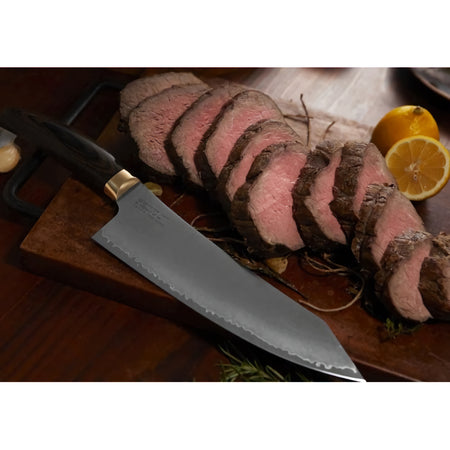Introduction
In the kitchen, the right knife makes work easier, safer and the end result cleaner. A single general-purpose knife, such as a chef's knife, will do the trick, but specialty knives bring convenience and precision to different situations. In this article, you'll find the most important types of knives and their uses – from general-purpose chef's knives to specialty knives, such as tomato and pastry knives.
🥩 Chef's knife (Gyuto)
-
The most versatile kitchen knife.
-
Length usually 20 cm, but varies from 15–40 cm.
-
Suitable for vegetables, fruit, meat and fish.
-
The curvature of the blade allows for a rocking cutting motion.
🥬 Santoku
-
A Japanese-style utility knife, especially popular for processing vegetables.
-
Blade 12–18 cm.
-
Straight cutting motion, not as good for cutting meat as a chef's knife.
-
Some models have oval grinds that prevent food from sticking to the blade.
🥕 Nakiri
-
Rectangular vegetable knife.
-
Blade 14–18 cm.
-
Especially suitable for finely chopping root vegetables and vegetables.
-
Supports the cutting movement well against the knuckles of the fingers.
🐟 Filleting knife
-
Thin and flexible blade for filleting fish and slicing meat.
-
Length 16–32 cm – the larger the fish, the longer the knife.
-
A long and sharp filleting knife ensures a clean cut, for example when making gravy.
🍎 Vegetable knife
-
Short-bladed, usually 10–15 cm.
-
Suitable for chopping small vegetables and fruits.
-
Handy for precise work, and a good alternative if big knives feel clumsy.
🥔 Paring knife
-
Short 6–8 cm blade.
-
Available in straight and curved (“nail blade”).
-
Used for peeling vegetables, roots and fruits, as well as for precision work, such as cleaning mushrooms.
🍞 Bread knife
-
Long, serrated blade.
-
Length usually 20–22 cm.
-
Effortlessly cut crispy breads and soft pastries.
🍰 Pastry knife
-
A long, serrated knife with a rounded tip.
-
Length 25–26 cm.
-
Suitable for cutting cakes, pies and other baked goods without the dough sticking to the blade.
🍅 Tomato knife
-
A small serrated knife, often 11 cm.
-
Designed specifically for tomatoes, but also works great for other soft vegetables and fruits.
-
Also handy for the breakfast table.
🥩 Boning knife
-
Stiff and narrow blade, approx. 16 cm.
-
Intended for cutting around meat and bones.
-
An excellent tool for handling game and large pieces of meat.
🦌 Skinning knife
-
A curved-bladed and stiff knife.
-
Blade length 12–18 cm.
-
Designed specifically for opening and skinning game.
🇨🇳 Chinese chef's knife (Cleaver)
-
High and rectangular blade.
-
Suitable for chopping vegetables, chopping herbs and, in some models, also cutting light bones.
🍣 Yanagiba (sashimi knife)
-
A long, narrow and single-sided sharpened knife.
-
Designed for slicing fish – perfect for sushi and sashimi dishes.
🐡 Deba
-
A strong, thick-bladed knife.
-
Designed for gutting fish and cutting small bones.
🔪 Kiritsuke
-
Long, straight tip and narrow blade.
-
Combines the features of a chef's knife and a sashimi knife.
-
Requires skill, traditionally a master knife.
🧀 Cheese knife
-
Designed for cutting various types of cheese.
-
The perforated blade prevents soft cheeses from sticking.
-
A stronger, shorter blade is used for hard cheeses.
🥩 Steak knives
-
A table knife, especially for eating meat dishes.
-
Often serrated, allowing meat to be cut easily without tearing.
🍖 Meat knife (Carving knife)
-
A long and narrow knife for slicing large pieces of meat, such as roast or turkey.
-
Often used in conjunction with a fork.
Summary
The right knife makes cooking smooth and enjoyable. A chef's knife or santoku is enough for many people, but specialty knives make special situations easier: a filleting knife for fish, a bread knife for crispy crust, a tomato knife for soft vegetables, and a skinning knife for handling game. When you know the types of knives, you can find the right tool for your needs – and cooking becomes more enjoyable.


